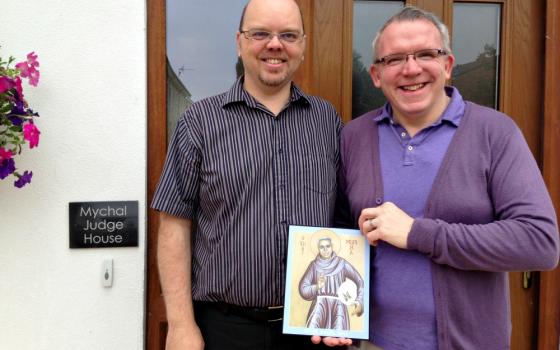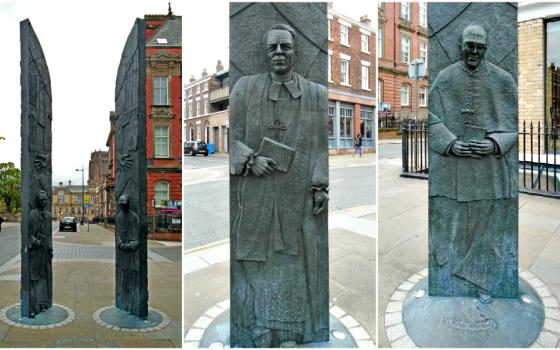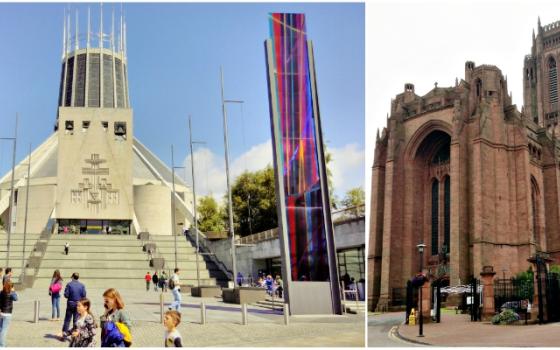Standing in Hope Street, I gazed in awe at the Cathedral Church of Christ, the fifth-largest cathedral in the world and the seat of the Anglican bishop of Liverpool, England. The Gothic structure dominates its surroundings. It's plainly visible from the immediate neighborhood and from a great distance. Its dark stone and impressive height give it a charming medieval touch, even though it was built in the 20th century.
"Turn around," my host, Kieran Bohan, said. "Look about a half mile up Hope Street. See the Roman Catholic cathedral? Now let me fill you in on the story that you won't read about in their promotional brochures."
Kieran told me that, because of the influx of Irish migrants in the 19th century, Liverpool was a very Catholic city. Just as in Ireland, there was much rivalry and tension between Protestants and Catholics. Of course, the Catholic cathedral would have to be larger, higher and grander than the Protestant one, but lack of funds and the outbreak of world wars put an end to that grandiose idea.
The Catholic cathedral, called the Metropolitan Cathedral of Christ the King, was completed in 1967, shortly after the Second Vatican Council. It is a beautiful and light-filled circular space that exudes the liturgical spirit of Vatican II. But in the late 1960s, with the rise of the Irish Republican Army and the troubles in Northern Ireland, the rivalry and distrust among Catholics and Protestants persisted.
It took the leadership of two archbishops of Liverpool — the Anglican David Sheppard and the Roman Catholic Derek Worlock — to ease religious and social tensions during the dark days of the 1970s and 1980s. Their commitment to the poor, unemployed and marginalized and their example of ecumenical cooperation prevented Liverpool from becoming another Belfast.
Halfway down Hope Street, as if to join the two cathedrals, is a 15-foot bronze sculpture that memorializes the two prelates. The people of Liverpool, who contributed financially to make the memorial possible, were encouraged to work together, pray together and learn together because of these two religious leaders whose friendship broke down long-standing barriers.
I thought of my own dark days in ecumenical relations when I was growing up in Philadelphia in the 1950s. The teachers in my Catholic grade school warned us not to walk on "the other side of the street" where the public school was located. If we didn't walk in front of the school, then surely we would never set foot in a Protestant church. "We don't mix with publics," sister said emphatically.
I was buried in a Catholic cocoon for most of my educational life: Catholic grade and high school, a Catholic college, followed by the University of Notre Dame. That all changed in the 1970s, when I encountered a world of non-Catholics at the University of Pennsylvania. In fact, it was the Episcopal church on campus that played a part in introducing me to my lifelong ministry on behalf of LGBT people.
Real leaders help us to come out of our cocoons. They move our hearts to conversion; they motivate and inspire what is noble in the human soul. Real leaders model what I call "embracing the other."
By embracing the other, we learn to overcome our prejudice toward those who are different from us. We in the U.S. need a strong dose of "embracing the other." The almost daily political talk of deporting undocumented persons, banning immigrants from predominantly Muslim countries, and tampering with the health care system and with government programs that benefit the poor all reflect a rejecting, not an embracing, of the other.
To embrace the other means extending a hand of friendship to those who may be strangers and helping the marginalized to aspire to new horizons. It means challenging a system that claims that some people are less deserving than others. To embrace the other is to underscore the good in each person and help to bring out their best.
Embracing the other begins with recognizing differences and accepting that they are just that — differences that do not require a value judgment. I had to check myself from thinking that the drivers in England were on the wrong side of the road. Driving cars in the right lane is not substandard or hazardous; it's just different from my experience. And I saw many people, including the not so young, with orange or purple hair. I reminded myself that these people are not bizarre or weird; their personal expressions are merely different from mine. Embracing the other begins with accepting differences.
My host, Kieran, and his partner, Warren Hartley, are good examples of accepting differences. Kieran is Catholic and a morning person; Warren is Anglican and a night person. Warren loves cats but Kieran is allergic to them. Warren likes watching documentaries and reading nonfiction; Kieran prefers comedies and fiction.
While they are distinct in their tastes or predilections, they have embraced the other, as well as embracing various social projects. The Anglican Diocese of Liverpool has commissioned them as local missional leaders for their ministry with LGBT Christians.
Kieran and Warren named their home the Fr. Mychal Judge House in honor of the Franciscan priest who is often referred to as "victim number one" in the Sept. 11, 2001, terrorist attack on the World Trade Center in New York City. Judge was a chaplain for the New York City Fire Department and an unofficial chaplain for the lesbian and gay community. He ministered selflessly to the hungry and homeless, those suffering from addictions, people with HIV/AIDS, immigrants and those feeling alienated in any way. Fr. Mychal Judge truly embraced the other.
When I left Liverpool, I felt I had been in touch with three clerics who brought hope and reconciliation where there was devastation and despair. I also now had two new friends whose faith impels them to live with integrity as they serve the human community. It seemed that I had been on a mini-retreat because God had lavishly bestowed five people into my life to show me how to "embrace the other." I hope I can follow their example.
[Jeannine Gramick is a Sister of Loretto who has been involved in a pastoral ministry for lesbian and gay Catholics since 1971. She co-founded New Ways Ministry and has been an executive coordinator of the National Coalition of American Nuns since 2003.]



